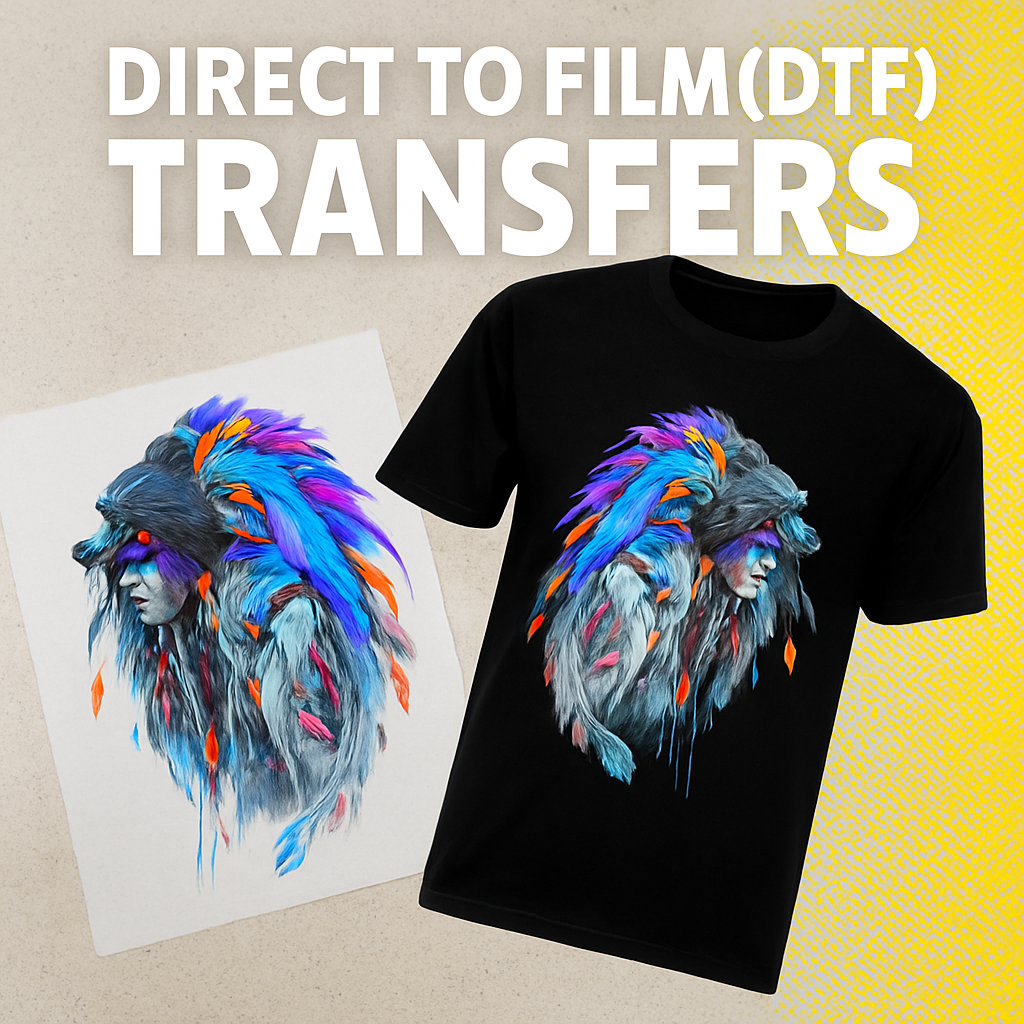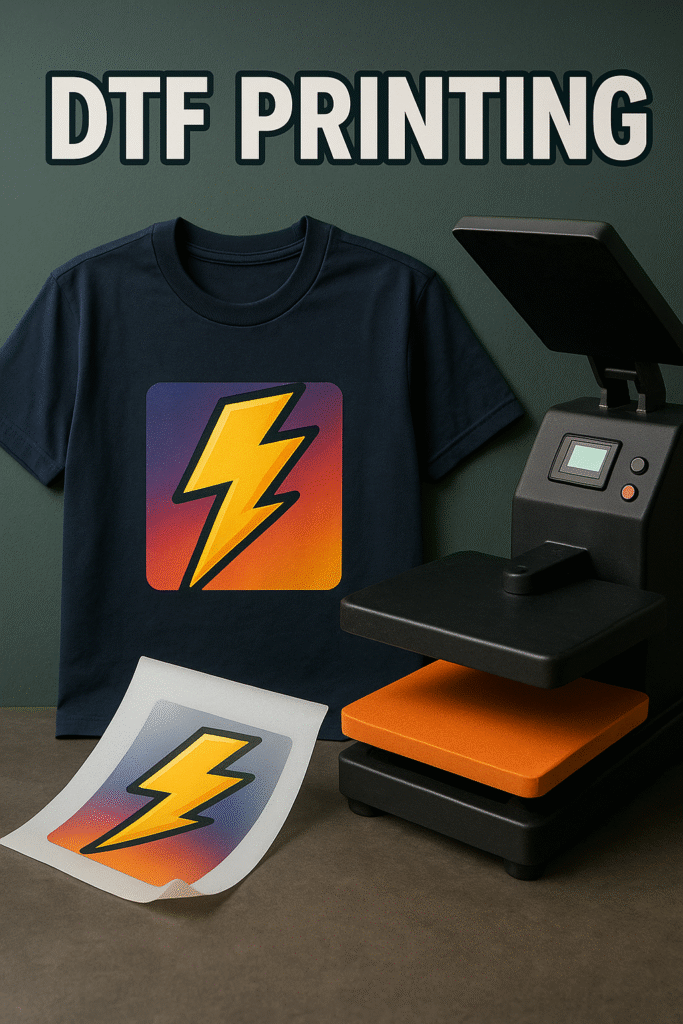What is Direct to Film (DTF) Transfer Printing? A Beginner-Friendly Guide
If you are diving into the world of custom apparel or thinking about launching a print on demand business. You have probably come across popular printing methods like screen printing, heat transfer vinyl or DTG (Direct to Garment). But there is a newer technique making serious waves in the industry — Direct to Film transfer printing.
Whether you are a designer building your brand or simply curious about how those eye-catching, high-quality DTF transfers for shirts come to life, here you will get everything you need to know about Direct to Film Transfer (DTF) printing — how it works, what makes it stand out and why it is quickly becoming the go to choice for creators everywhere.
What is DTF Transfer Printing?
Direct to Film Transfer printing is a process in which you print your design onto a special film using a DTF printer. The design is then transferred to fabric using heat and pressure. While the process is simple, it produces results that are long-lasting and incredibly vibrant.
Unlike traditional printing techniques, DTF heat transfers do not require pre-treating the fabric or limiting yourself to cotton materials. You can apply your designs to a variety of fabrics.
How Does DTF Work?
Here’s how DTF printing goes from digital artwork to finished product:
1. Design Creation
Create a bold design, whether it’s a logo or an illustration, using software like Photoshop, Illustrator, or Canva. Save your file in a high-resolution PNG format with a transparent background to ensure a professional finish. Make your work stand out!
2. Print on PET Film
Use a DTF printer with special textile inks to print your design in reverse onto a PET film (a type of clear plastic sheet). The printer first lays down colored ink, followed by a white layer on top, which enhances the vibrancy of the colors — especially on dark fabrics.
3. Add Hot-Melt Powder
While the ink is still wet, a hot-melt adhesive powder is sprinkled over the design. This acts as a glue that bonds the design to the fabric. The excess powder is removed by shaking the sheet.
4. Cure the Powder
Next, the printed film is lightly heated to melt and activate the powder. This sets up the transfer to be applied.
5. Transfer to Fabric
Place the film ink-side down onto the fabric and use a heat press (typically set to 290–325°F for 10–15 seconds) to transfer the design from the film to the fabric.
6. Cold Peel
Allow the DTF transfer sheets to cool completely before peeling it off. You will be left with a vibrant and smooth design printed directly onto the fabric.

Why Choose DTF Printing?
Print on Any Fabric
DTF Transfer sheets work on almost all types of fabric — cotton, polyester, tri-blends, and more. That’s a huge plus over DTG (Direct to Garment), which works best only on cotton.
No Pre-Treatment Required
DTF skips the messy and time-consuming step of pre-treating fabric. That’s one less step between you and your finished product.
Long-Lasting Prints
Direct To Film transfers are wash-resistant and flexible. They won’t crack or peel easily, making them great for activewear or daily-use clothing.
Sharp and Bright Colors
DTF prints come out crisp, vibrant and detailed designs – perfect for logos, gradients, or full-color artwork.
Ideal for Small or Large Runs
You can print just one shirt or a thousand. It’s affordable for short runs and scalable for big batches.
How does DTF compare to Other Printing Methods?
| Printing Type | Works On All Fabrics | Needs Pretreatment | Color Quality | Good for Small Batches | Durability |
| DTF Printing | Yes | No | Excellent | Yes | High |
| DTG Printing | Mostly Cotton | Yes | Excellent | Yes | Medium |
| Screen Printing | Best on cotton/poly | Sometimes | Good | Expensive setup | High |
| Vinyl Heat Transfer | Limited | No | Good | Yes | Medium |
| Sublimation | Polyester Only | No | Excellent | Yes | High |
Who Should Use DTF Transfers?
- Small business owners selling custom t-shirts, hoodies and any apparel
- Event organizers needing uniforms or merch quickly
- Local print shops expanding their services
- DIY crafters and Etsy sellers looking to print on demand
- Designers wanting to test new designs without a large investment
If you’re into printing or starting a custom product business, DTF USA gives you high-quality results without big equipment or large investments.
Final Thoughts: Is Direct To Film Transfer Printing Worth It?
Yes, Direct To Film transfers printing is one of the easiest, most flexible and cost-effective methods to bring custom designs to life. Whether you want to create your t shirt brand or grow your print-on-demand business. DTF is a powerful tool to have in your kit. It’s low effort, high impact and honestly, pretty fun to work with.
FAQs About Direct To Film Transfer Printing
- Can beginners use DTF?
Absolutely. You can buy custom DTF transfers online and apply them at home using a heat press — no printing experience required. - Do DTF prints crack or peel?
No — if DTF directions/application is correct, DTF transfers are highly durable, flexible, and last through dozens of washes. - What kind of heat press do I need?
A standard clamshell or swing-away heat press works well. You need consistent heat and pressure for the best transfer. - Can I store unused DTF transfers?
Yes! Once cured, you can store printed film sheets and apply them later. Just keep them in a cool, dry place.


